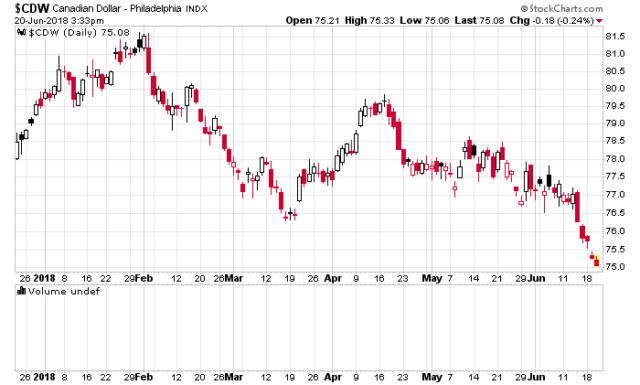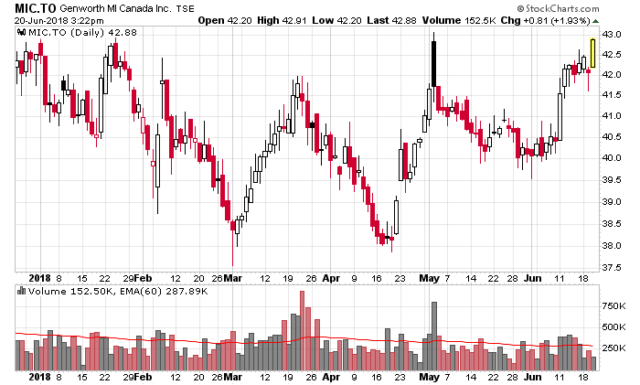I very much like reading the short sale cases of anything I hold. It forces you to check your own analysis and compare conclusions. I remember dissecting a post back in October 2016 that was posted on Seeking Alpha (David Desjardins said he bought January 2018 put options at a strike price of 18 – if held to maturity they would have expired out of the money).
The newest case I’ve read is from Tim Bergin, who wrote extensively about it on his website and even won the runner-up status in an investment idea contest (something to be fairly proud about considering the quality of presentations that go into these sorts of things – there is a large amount of raw financial brainpower that want to be noticed by hedge fund managers).
I agree with some of Tim Bergin’s analysis of Genworth MI (TSX: MIC), but there are some missing elements of the analysis. This post may appear to be a bit critical and if Tim – you’re reading this – please note I appreciate your work much more than what this post is letting on!
Items I agree with
* I generally agree that the maximum upside (as a short-seller this would be downside), in the short-term time horizon, is about 20-30%.
* I also agree that if the facts in his thesis materialize (specifically: 5-15% mortgage default rates, 20-40% housing price declines) that the price of Genworth MI will drop 60-100%. I believe that his projections are actually conservative if this occurs (i.e. the numbers he presented will be worse).
* B-20 will impact housing prices. What this will typically result in, however, is that would-be buyers would shop for lower valued properties that can fit the financing parameters.
* The correlated risks in the investment portfolio (e.g. debt/preferred share investments in financials that would presumably be linked to real estate credit markets).
* Using LTV and amortization is not a sound way of pricing an insurance product, but this is due to consumer simplicity and also just matching whatever CMHC charges – in any event, if the market was actually competitive, based on loss ratios, mortgage insurance premiums would be much lower.
Items I disagree with
* The analysis seems heavy on severity and not frequency. The trigger point for frequency is not debt ratios, but rather employment (something not discussed in the presentation).
* The most fatal flaw in the presentation: The “soft-landing” scenario (slide 26). Reading the slides, I don’t get the impression the author is differentiating between revenue recognition and premiums written. Cash intake (premiums written) in FY2017 was $663 million. Even if the company only recognized revenues on a 10-year basis (this modelling is also flawed), in a “soft landing” scenario, the revenue recognition would normalize to the rate that premiums were being written. There is no explanation for why premiums written would drop by 60%.
* The conversion to “actual loan-to-value (LTV)” (slide 19) is a very creative way to bloat the ratio and implies the liability book is larger than it may seem, but ultimately it doesn’t mean anything – the fact that it takes money to dispose of delinquent properties is known and banks also incur the same risks, or in any industry where there is collateral backing loans.
* The 10-year revenue recognition suggestion doesn’t make sense. Looking at FY2017 year end, the average transactional mortgage insurance LTV is 62% – each and every year after the mortgage loan is amortized even further, reducing risk. So even in the event that housing prices drop 25% universally, the LTV still is 83% – defaults that occur will not be severe, unless if the defaults are part of a (my terminology) “cascade selling” where selling of defaulted properties causes further price drops. What would the accounting basis be for delaying recognition of revenues that has an incredibly high probability of never incurring further cost? It’s pretty self-evident that the further the LTV drops (whether it is due to appreciation of property or amortization of debt) the less risky the insurance written is. Of course in a declining housing price environment, LTVs may go above 90% and then it becomes reliant on the mortgage holder to continue paying down the mortgage and amortizing debt instead of having the safety valve of just selling the property (which would explain how Home Capital Group and others got away with sloppy underwriting).
* In relation to US mortgages (strategic defaults), recourse in Canada is quite powerful.
* That MIC’s insurance portfolio is weaker because of the reduced (90%) government backstopping. Performance data between CMHC and MIC (loss ratios) would suggest otherwise. I agree I don’t know why this is the case, but it would suggest that MIC does have better screening techniques.
Items that should be in the analysis but isn’t mentioned
* That as long as CMHC profits from mortgage insurance that Genworth MI will as well and any “crash” scenario will also greatly affect the government (with even more political consequences than financial ones), thus the federal government has a high incentive to preventing a crash scenario from occurring.
* If mortgage insurance was such a crappy deal for MIC (and by extension CMHC), would they not have a justification to raise insurance rates even further, just like how they did when the OSFI raised mortgage insurance capital requirements?
* MIC’s data from the 2008-2009 economic crisis seemed to suggest that even in a sour economy that they can still make money.
* Genworth Financial’s 57% ownership in MIC is a big question mark considering the China Oceanwide merger process (that has been going on for over a year).
* What if MIC just said the following tomorrow: “We’ve stopped writing mortgage insurance. We will be letting our existing insurance book run to expiry and distribute the remaining free equity to shareholders.” – what is the terminal value of MIC in this case?
Closing Thoughts
I’ll be happy to let Tim Bergin borrow my shares of MIC if he wishes to short it. The market currently asks 2.4% for a borrow, plus 4.7% carrying costs for quarterly dividends.

